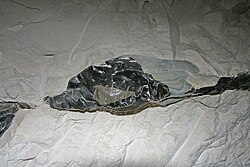Krzemionki
| Prehistoric flint mining in Krzemionki | |
|---|---|
|
UNESCO world heritage |
|

|
|
| Flint vein |
|
| National territory: |
|
| Type: | Culture |
| Criteria : | (iii) (iv) |
| Surface: | 342.2 ha |
| Buffer zone: | 1828.7 ha |
| Reference No .: | 1599 |
| UNESCO region : | Europe and North America |
| History of enrollment | |
| Enrollment: | 2019 ( session 43 ) |
Krzemionki is a flint mine located about eight kilometers (as the crow flies) northeast of the Polish city of Ostrowiec Świętokrzyski in the Góry Świętokrzyskie (Holy Cross Mountains). In July 2019 it was declared a World Heritage Site by UNESCO .
Krzemionki is the largest flint mine in Europe. The banded flint that was extracted was mainly processed into hatchets . The approximately 2000 shafts are four to twelve meters deep. It was Jurassic mined Flint, which is characterized by its harness. There is a small rock carving in one of the shafts. The quarrying of flint in Krzemionki began around 3900 BC. And lasted until about 1600 BC. The mine was used in the Neolithic by members of the funnel cup culture. The Krzemionki flint spread up to 300 km. The spherical amphora culture used the pits even more intensively and spread the flint about 500 km away. Krzemionki was still important in the Bronze Age and the flint only spread about 60 km far.
Research history
The shafts were discovered in 1922 by Jan Samsonowicz and described for the first time by Stefan Krukowski . Since then excavations have taken place several times. The shafts and pitches were partially damaged by the quarrying of limestone for steel production . The facility is part of the Warsaw Archaeological Museum .
museum
Today the site is an archaeological reserve with several protective structures in which there is a museum presentation. Some of the shafts are open to the public. The Pingenfeld is covered by forest. There is also an open-air museum on the premises with life-size models of some prehistoric houses.
literature
- Aleksander Dzbyński: Megaliths and axes - the meaning of flint objects during the early Copper Age. In: Hans-Jürgen Beier , Erich Claßen , Thomas Doppler, Britta Ramminger (eds.): Neolithic monuments and neolithic societies. Contributions from the meeting of the Neolithic Working Group during the annual meeting of the North-West German Association for Ancient Research in Schleswig, 9. – 10. October 2007 (= Varia neolithica. 6 = contributions to the prehistory and early history of Central Europe. 56). Beier & Beran, Langenweissbach 2009, ISBN 978-3-941171-28-2 , pp. 105-110.
- Martin Jahn : The oldest mining in Europe (= treatises of the Saxon Academy of Sciences in Leipzig. Philosophical-historical class. 52, 2, ZDB -ID 219474-0 ). Akademie-Verlag, Berlin 1960, pp. 43–54, plates III – IV.
- Stefan Krukowski: Krzemionki Opatowskie. Nakładem Muzeum Techniki i Przemysłu, Warszawa 1939.
Web links
Individual evidence
- ↑ Krzemionki Prehistoric Striped Flint Mining Region. UNESCO World Heritage Center, accessed July 9, 2019 .
Coordinates: 50 ° 58 ′ 22 ″ N , 21 ° 29 ′ 39 ″ E



